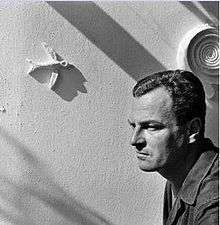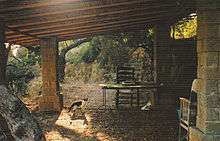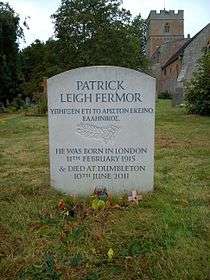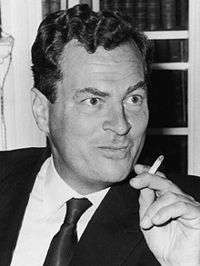Patrick Leigh Fermor
| Sir Patrick Leigh Fermor | |
|---|---|
|
Leigh Fermor in 1966 | |
| Born |
Patrick Michael Leigh Fermor 11 February 1915 London, England |
| Died |
10 June 2011 (aged 96) Dumbleton, England |
| Occupation | Author, scholar and soldier |
| Nationality | British |
| Genre | Travel |
| Notable works | A Time of Gifts |
| Notable awards | Knight Bachelor; Distinguished Service Order; Officer of the Order of the British Empire |
| Spouse | Hon. Joan Elizabeth Rayner |
|
Military career | |
| Allegiance |
|
| Service/branch |
|
| Years of service | 1940–1946 |
| Rank | Major |
| Battles/wars | Second World War |
| Awards |
Distinguished Service Order Officer of the Order of the British Empire |
Sir Patrick Michael Leigh Fermor, DSO, OBE (11 February 1915 – 10 June 2011), also known as Paddy Fermor, was a British author, scholar and soldier who played a prominent role behind the lines in the Cretan resistance during the Second World War.[1] He was widely regarded as Britain's greatest living travel writer during his lifetime,[2] based on books such as A Time of Gifts (1977). A BBC journalist once described him as "a cross between Indiana Jones, James Bond and Graham Greene."[3] The Patrick Leigh Fermor Society was formed in 2014.[4]
Early life and education
Leigh Fermor was born in London, the son of Sir Lewis Leigh Fermor, a distinguished geologist, and Muriel Aeyleen, daughter of Charles Taafe Ambler.[5] Shortly after his birth, his mother and sister left to join his father in India, leaving the infant Patrick in England with a family in Northamptonshire. He did not meet his family in person until he was four years old. As a child, Leigh Fermor had problems with academic structure and limitations. As a result, he was sent to a school for "difficult children". He was later expelled from The King's School, Canterbury, when he was caught holding hands with a greengrocer's daughter.
His last report from The King's School noted that the young Leigh Fermor was "a dangerous mixture of sophistication and recklessness."[6] He continued learning by reading texts on Greek, Latin, Shakespeare and History, with the intention of entering the Royal Military College, Sandhurst. Gradually he changed his mind, deciding to become an author instead, and in the summer of 1933 relocated to Shepherd Market in London, living with a few friends. Soon, faced with the challenges of an author's life in London and rapidly draining finances, he set upon leaving for Europe.[7]
Early travels
At the age of 18, Leigh Fermor decided to walk the length of Europe, from the Hook of Holland to Constantinople (Istanbul).[8] He set off on 8 December 1933, less than a year after Hitler had come to power in Germany, with a few clothes, several letters of introduction, the Oxford Book of English Verse and a Loeb volume of Horace's Odes. He slept in barns and shepherds' huts, but also was invited by landed gentry and aristocracy into the country houses of Central Europe. He experienced hospitality in many monasteries along the way. Two of his later travel books, A Time of Gifts (1977) and Between the Woods and the Water (1986), were about this journey. A book on the final part of his journey was unfinished at the time of Leigh Fermor's death, but was published as The Broken Road: Travels from Bulgaria to Mount Athos in September 2013 by John Murray. The book draws on Leigh Fermor's diary at the time and on an early draft he wrote in the 1960s.[9]
Leigh Fermor arrived in Istanbul on 1 January 1935, then continued to travel around Greece. In March, he was involved in the campaign of royalist forces in Macedonia against an attempted Republican revolt. In Athens, he met Balasha Cantacuzène (Bălaşa Cantacuzino), a Romanian Phanariote noblewoman, with whom he fell in love. They shared an old watermill outside the city looking out towards Poros, where she painted and he wrote. They moved on to Băleni, Galați, the Cantacuzène house in Moldavia, Romania, where he remained until the autumn of 1939.[1] On learning that Britain had declared war on Germany on 3 September 1939, Leigh Fermor immediately left Romania to return home and enlist in the army.[10]
Second World War

As an officer cadet, Leigh Fermor trained alongside Derek Bond[11] and Iain Moncreiffe, and later joined the Irish Guards. Due to his knowledge of modern Greek, he was commissioned in the General List in August 1940[12] and became a liaison officer in Albania. He fought in Crete and mainland Greece. During the German occupation, he returned to Crete three times, once by parachute. He was one of a small number of Special Operations Executive (SOE) officers posted to organise the island's resistance to the occupation. Disguised as a shepherd and nicknamed Michalis or Filedem, he lived for over two years in the mountains. With Captain Bill Stanley Moss as his second in command, Leigh Fermor led the party that in 1944 captured and evacuated the German commander, General Heinrich Kreipe.[13] There is a memorial commemorating Kreipe's abduction near Archanes in Crete.[14]
Moss featured the events of the Cretan capture in his book Ill Met by Moonlight.[6] (The 2014 edition contains an Afterword written by Leigh Fermor in 2001, setting the context of the operation.) It was later adapted in a film by the same name. It was directed/produced by Michael Powell and Emeric Pressburger and released in 1957. In the film, Leigh Fermor was portrayed by Dirk Bogarde.[1] Leigh Fermor's own account Abducting A General – The Kreipe Operation and SOE in Crete was published in October 2014.[15][16]
Wartime honours and legacy
- Officer of the Most Excellent Order of the British Empire (OBE)[17]
- The Distinguished Service Order (DSO)[18]
- Honorary Citizen of Heraklion, of Kardamyli and of Gytheio
The National Archives in London holds copies of Leigh Fermor's wartime dispatches from occupied Crete in file number HS 5/728.

Post war

In 1950, Leigh Fermor published his first book, The Traveller's Tree, about his post-war travels in the Caribbean. The book won the Heinemann Foundation Prize for Literature and established his career. The reviewer in The Times Literary Supplement wrote: "Mr Leigh Fermor never loses sight of the fact, not always grasped by superficial visitors, that most of the problems of the West Indies are the direct legacy of the slave trade."[19] It was quoted extensively in Live and Let Die, by Ian Fleming.[20] He went on to write several further books of his journeys, including Mani and Roumeli, of his travels on mule and foot around remote parts of Greece.




Leigh Fermor translated the manuscript The Cretan Runner written by George Psychoundakis, a dispatch runner on Crete during the war, and helped Psychoundakis get his work published. Fermor also wrote a novel, The Violins of Saint-Jacques, which was adapted as an opera by Malcolm Williamson. His friend Lawrence Durrell, in Bitter Lemons (1957), recounts how, during the Cypriot insurgency against continued British rule in 1955, Leigh Fermor visited Durrell's villa in Bellapais, Cyprus:
After a splendid dinner by the fire he starts singing, songs of Crete, Athens, Macedonia. When I go out to refill the ouzo bottle...I find the street completely filled with people listening in utter silence and darkness. Everyone seems struck dumb. 'What is it?' I say, catching sight of Frangos. 'Never have I heard of Englishmen singing Greek songs like this!' Their reverent amazement is touching; it is as if they want to embrace Paddy wherever he goes.[21]
Later years
After many years together, Leigh Fermor was married in 1968 to the Honourable Joan Elizabeth Rayner (née Eyres Monsell), daughter of Bolton Eyres-Monsell, 1st Viscount Monsell. She accompanied him on many of his travels until her death in Kardamyli in June 2003, aged 91. They had no children.[22] They lived part of the year in their house in an olive grove near Kardamyli in the Mani Peninsula, southern Peloponnese, and part of the year in Gloucestershire.
Leigh Fermor was knighted in the 2004 New Years Honours.[23] In 2007, he said that, for the first time, he had decided to work using a typewriter, having written all his books longhand until then.[2] The house at Kardamyli was featured in the 2013 film Before Midnight.[24]
Fermor is considered to set a standard of modern travel writing, in particular, with this 1977 book A Time of Gifts. He influenced the whole generation of British writers such as Bruce Chatwin, Colin Thubron, Philip Marsden, Nicholas Crane, and Rory Stewart.[25]
Death and funeral
Leigh Fermor was noted for his strong physical constitution, even though he smoked 80 to 100 cigarettes a day.[26] Although in his last years he suffered from tunnel vision and wore hearing aids, he remained physically fit up to his death and dined at table on the last evening of his life.
For the last few months of his life Leigh Fermor suffered from a cancerous tumour, and in early June 2011 he underwent a tracheotomy in Greece. As death was close, according to local Greek friends, he expressed a wish to visit England to say good-bye to his friends, and then return to die in Kardamyli, though it is also stated that he actually wished to die in England and be buried next to his wife.[27]
Leigh Fermor died in England, aged 96, on 10 June 2011, the day after his return.[28] His funeral took place at St Peter's Church, Dumbleton, Gloucestershire on 16 June 2011. A Guard of Honour was provided by serving and former members of the Intelligence Corps, and a bugler from the Irish Guards sounded the Last Post and reveille. Leigh Fermor is buried next to his wife in the churchyard at Dumbleton.
Awards and legacy

- 1950, Heinemann Foundation Prize for Literature for The Traveller's Tree
- 1978, WH Smith Literary Award for A Time of Gifts.
- 1991, elected an Honorary Fellow of the Royal Society of Literature[29]
- 1995, Chevalier, Ordre des Arts et des Lettres[30]
- February 2004, accepted the knighthood (Knight Bachelor) which he had declined in 1991.[31]
- 2004, awarded the Lifetime Achievement Award of the British Guild of Travel Writers.
- 2007, the Greek government made him Commander of the Order of the Phoenix.[2]
- His life and work were profiled by the travel writer Benedict Allen in the documentary series Travellers' Century (2008) on BBC Four.
- A documentary film on the Cretan resistance The 11th Day (2003) contains extensive interview segments with Leigh Fermor in which he recounted his service in the S.O.E. and his activities on Crete, including the capture of General Kreipe.
Works
Books
- The Traveller's Tree (1950)
- The Violins of Saint-Jacques (1953)
- A Time to Keep Silence (1957), with photographs by Joan Eyres Monsell.[32] This was an early publication from the Queen Anne Press, a company managed by Leigh Fermor's friend Ian Fleming.
- Mani: Travels in the Southern Peloponnese (1958)
- Roumeli: Travels in Northern Greece (1966)
- A Time of Gifts – On Foot to Constantinople: From the Hook of Holland to the Middle Danube (1977, published by John Murray)
- Between the Woods and the Water (1986)
- Three Letters from the Andes (1991)
- Words of Mercury (2003), edited by Artemis Cooper
- Introduction to Into Colditz by Lt Colonel Miles Reid, Michael Russell Publishing Ltd, Wilton (1983). The story of Reid's captivity in Colditz and eventual escape by faking illness so as to qualify for repatriation. Reid had served with Leigh Fermor in Greece and was captured there trying to defend the Corinth Canal bridge in 1941.
- Foreword of Albanian Assignment by Colonel David Smiley, Chatto & Windus, London (1984). The story of SOE in Albania, by a brother in arms of Leigh Fermor, who was later a MI6 agent.
- In Tearing Haste: Letters Between Deborah Devonshire and Patrick Leigh Fermor (2008), edited by Charlotte Mosley. Deborah Cavendish, Duchess of Devonshire, the youngest of the six Mitford sisters, was the wife of the 11th Duke of Devonshire.
- The Broken Road (2013), edited by Artemis Cooper and Colin Thubron from PLF's unfinished manuscript of the third volume of his account of his walk across Europe in the 1930s.[33]
- Abducting A General – The Kreipe Operation and SOE in Crete (2014)
Translations
- No Innocent Abroad (published in USA as Forever Ulysses) by C. P. Rodocanachi (1938)
- The Cretan Runner: His Story of the German Occupation by George Psychoundakis (1955)
- Julie de Carneilhan and Chance Acquaintances by Colette (1952)
Screenplay
- The Roots of Heaven (1958) adventure film, directed by John Huston
Periodicals
- 'A Monastery', in The Cornhill Magazine, London, no. 979, Summer, 1949.
- 'From Solesmes to La Grande Trappe', in The Cornhill Magazine,[34] John Murray, London, no. 982, Spring 1950.
- 'Voodoo Rites in Haiti, in World Review, London, October 1950.
- 'The Rock-Monasteries of Cappadocia', in The Cornhill Magazine, London, no. 986, Spring 1951.
- 'The Monasteries of the Air', in The Cornhill Magazine, London, no. 987, Summer 1951.
- 'The Entrance to Hades',[35] in The Cornhill Magazine, London, no. 1011, Spring 1957.
See also
References
Notes
- 1 2 3 "Patrick Leigh Fermor (obituary)". London Daily Telegraph. 10 June 2011.
- 1 2 3 Smith, Helena "Literary legend learning to type at 92", The Guardian (2 March 2007)
- ↑ Woodward, Richard B. (11 June 2011). "Patrick Leigh Fermor, Travel Writer, Dies at 96". The New York Times. Retrieved 2011-06-11.
- ↑ The Patrick Leigh Fermor Society
- ↑ His mother, Muriel Eileen (or Aeyleen), who was born 26 April 1890 and died, at 54 Marine Parade, Brighton, on 22 October 1977, was the daughter of Charles Taafe Ambler (1840–1925) whose father was Warrant Officer (William) James Ambler on HMS Bellerophon, with Captain Maitland, when Napoleon surrendered. Muriel and Lewis married on 02.04.1890.
- 1 2 Cooper, Artemis (11 June 2011). "Sir Patrick Leigh Fermor: Soldier, scholar and celebrated travel writer hailed as the best of his time". The Independent. Retrieved 2011-06-11.
- ↑ Fermor, Patrick Leigh (2005). A time of gifts : on foot to Constantinople : from the Hook of Holland to the Middle Danube (Pbk ed.). New York: New York Review Books. ISBN 1-59017-165-9.
- ↑ Gross, Matt (23 May 2010). "Frugal Europe, on Foot". New York Times. Retrieved 2010-05-23.
It was December 1933, and an 18-year-old Englishman named Patrick Leigh Fermor put on a pair of hobnail boots and a secondhand greatcoat, gathered up his rucksack and left London on a ship bound for Rotterdam, where he planned to travel 1,400 miles to Istanbul—on foot.
- ↑ Flood, Alison. "Patrick Leigh Fermor's final volume will be published", The Guardian (20 December 2011)
- ↑ Cooper, Patrick Leigh Fermor: An Adventure, 2012, p.120
- ↑ Steady, Old Man! Don't You Know There's a War On, Derek Bond, (1990), Leo Cooper, London ISBN 0-85052-046-0 page 19
- ↑ "General List" London Gazette (20 August 1940) Issue 34928, p.10
- ↑ Howarth, Patrick. Undercover: The Men and Women of the SOE, London: Weidenfeld & Nicolson, 2000; ISBN 978-1-84212-240-2.
- ↑ Banasakis, Georgios. "Αφιερωμα ςτη μνημη της ομαδας απαγωγης του διοικητη των Γερμανικων Δυnαμεων κατοχης (ςτρατηγου Κραιπε) 24-04-1944" ("Tribute to the memory of the abduction of the Governor of the German occupation (General Kraipe) 24-04-1944") (photograph) (23 September 2008)
- ↑ Leigh Fermor, Patrick, Abducting a General, John Murray 2014
- ↑ Andy Walker (10 October 2014). "Patrick Leigh Fermor: Crossing Europe and kidnapping a German general". BBC News. Retrieved 10 October 2014.
- ↑ "To be Additional Officers of the Military Division of the said Most Excellent Order" London Gazette (14 October 1943) Issue 36209, page 4540
- ↑ "The Distinguished Service Order" London Gazette (13 July 1944) Issue 36605, page 3274
- ↑ Cooper, Patrick Leigh Fermor: An Adventure, 2012, p.250
- ↑ Chancellor, Henry (2005). James Bond: The Man and His World. London: John Murray. p. 43. ISBN 978-0-7195-6815-2.
- ↑ Durrell, Lawrence. Bitter Lemons, pp. 103–4
- ↑ "Joan Leigh Fermor" (obituary) The Independent (10 June 2003)
- ↑ Diplomatic Service and Overseas List London Gazette (31 December 2003)
- ↑ Brevet, Brad (22 May 2013). "Before Midnight Location Map – Celine and Jesse Vacation in Greece". Rope of Silicon. Retrieved 30 October 2013.
- ↑ Dalrymple, William (6 September 2008). "Patrick Leigh Fermor: The man who walked". The Telegraph. Retrieved 23 February 2016.
- ↑ "Travelling man: Biographer of a charmer" (review) The Economist (20 October 2012)
- ↑ "The Man of the Mani" BBC Radio 4 (22 June 2015)
- ↑ Associated Press
- ↑ "Royal Society of Literature All Fellows". Royal Society of Literature. Archived from the original on March 5, 2010. Retrieved 9 August 2010.
- ↑ "Fermor, Patrick MIchael Leigh" International Who's Who of Authors and Writers, 2004]
- ↑ Hastings, Max. "Patrick Leigh Fermor: Profile" London Daily Telegraph 4 January 2004)
- ↑ Campbell, James. "Patrick Leigh Fermor obituary" The Guardian (10 June 2011)
- ↑ Sattin, Anthony (15 September 2013). "The Broken Road - A Review". The Observer. Retrieved 22 August 2016.
- ↑ edited by Peter Quennell
- ↑ about the Mani
Further reading
- Cooper, Artemis Patrick Leigh Fermor: An Adventure (John Murray, 2012; New York Review of Books, 2013)
- Payás, Dolores Drink Time! (In the Company (En Compañía con) of Patrick Leigh Fermor) (Acantilado, 2013; Bene Factum Publishing 2014)
- John Ure (Jan 2015). "Fermor, Sir Patrick Michael [Paddy] Leigh (1915–2011)". Oxford Dictionary of National Biography (online ed.). Oxford University Press. doi:10.1093/ref:odnb/103763. (Subscription or UK public library membership required.)
External links
| Wikimedia Commons has media related to Patrick Leigh Fermor. |
- Andy Walker, Patrick Leigh Fermor: Crossing Europe and kidnapping a German general BBC 9 October 2014
- Faces of the Week: hear Leigh Fermor's voice there
- Long Distance Paths E6, E8 and E3 trace similar routes across Europe
- Official site of the documentary film The 11th Day which contains an extensive interview with Sir Patrick Leigh Fermor, and documents the Battle of Trahili, filmed in 2003.
- Works by or about Patrick Leigh Fermor in libraries (WorldCat catalog)
- Fermor's obituary in the Daily Mail: "The Lionheart who stole a Nazi – and the heart of every woman"
- Profile in the New Yorker by Anthony Lane; published 22 May 2006
